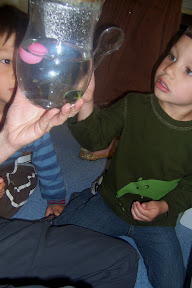When young children use magnifiers
By Peggy Ashbrook
Posted on 2010-04-21
I brought magnifiers into the twos classroom today as a tool for looking at dead insects (and a few other invertebrates) and butterfly eggs on collard plants. The children have used magnifiers many times before but they are always intrigued, and maybe even a little surprised, when things “get bigger”. One child asked why the magnifier made things bigger. I had him feel the shape of the lens to feel how the plastic curved and told him the curve bends the path of light so the image looks bigger. I don’t expect him to understand all of that, but we then looked at a Discovery Bottle which has two balls in water—one floating and one not. The floating pink ball is visible both above and below the waterline, and it looks noticeably bigger under the water. I asked the children, “Is the ball really bigger under the water or does it just look that way?” And then held my finger under a magnifier and asked, “Does my finger look bigger or did it really get bigger?” The children said it just looked bigger but felt my finger to check.
(Note that when we ask either-or questions, we tend to end with the “right” answer: “Should we use the magnifier for digging in the dirt or for looking?” Try to switch it up so you can tell if the children are really thinking about what you are asking or if they are responding to a pattern in questioning. Or ask open-ended questions, such as, “Tell me how this tool should be used.”)
What other experiences with light will prepare children to understand about how light forms images?
Peggy
Disclaimer: The views expressed in this blog post are those of the author(s) and do not necessarily reflect the official position of the National Science Teaching Association (NSTA).



